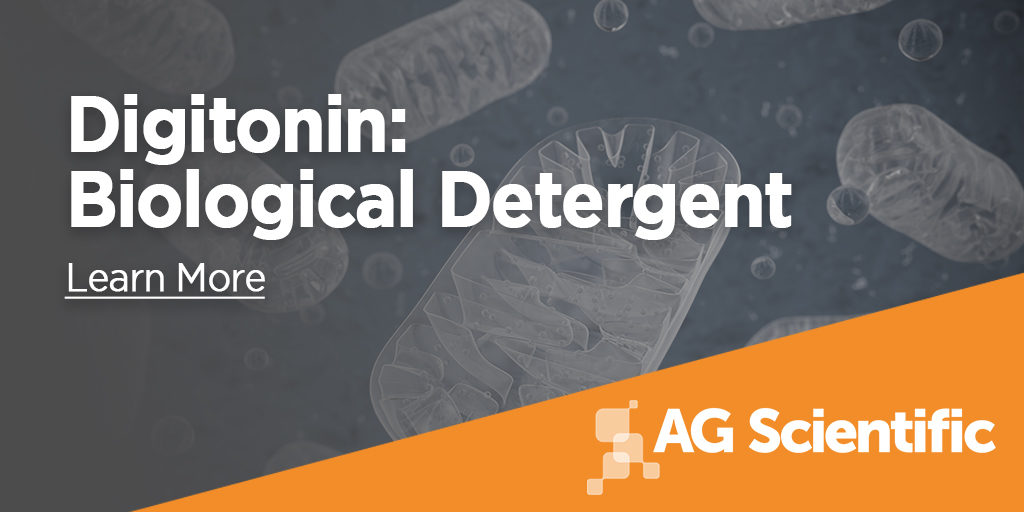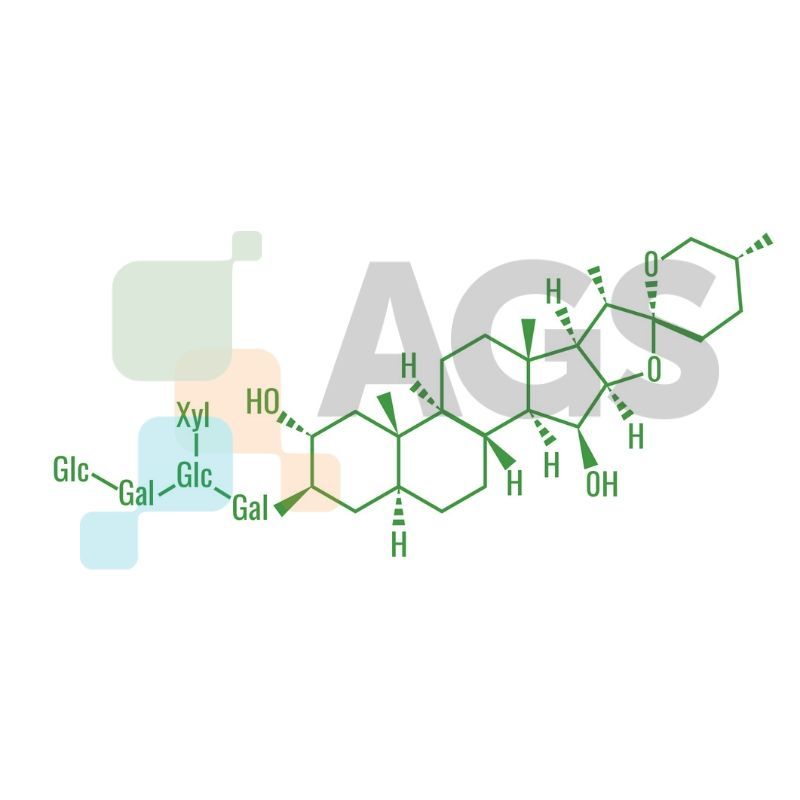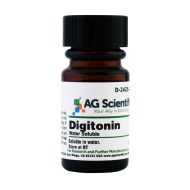Digitonin (C56H92O29) is a steroidal, monodesmosidic saponin (a toxic chemical with a plant-based origin) derived from the foxglove plant species, Lady’s Glove; Digitalis pupurea. The compound appears as a white or off-white powder under room temperature, and scientists often apply it as a biological detergent due to its capacity to water-solubilize lipids. The compound naturally occurs as a non-ionic surfactant (molecules that form sealed bubbles and lower surface tension between elements), with researchers commonly applying them in receptor solubilization processes.

Properties and Reactions of Digitonin
Digitonin has a melting point between 244.0–248.5 °C (471.2–479.3 °F) and weighs 1229.3 g/mol. The mild nonionic detergent works effectively in the structural analysis of proteins and does not leave precipitation upon dissolution in its natural form. However, aqueous preparations may result in precipitation when cooled down, causing a loss in chemical functions. Digitonin is a glycoside, where sugar binds itself to another functional group via a glycosidic bond.
The glycoside contains the aglycone digitogenin bound to five sugars. Digitonin functions as a nonionic detergent with an uncharged hydrophilic head group and is often used to break down chemical interactions involving proteins and lipids. Specifically, this detergent permeabilizes plasma membranes in eukaryotic cells by forming complexes with cholesterol and other similarly unconjugated β-hydroxysterols.
Research and Applications
Researchers commonly apply this detergent in studies that involve membrane proteins and isolation of mitochondria. Digitonin also exists in a wide range of processes, such as hemolysis (the destruction of red blood cells commonly caused by Gram-positive bacteria). A study on digitonin established the cholesterol-dependent mechanisms of the saponin. The experiment involved digitonin application with various natural and artificial membranes, including large unilamellar vesicles (LUVs) and giant unilamellar vesicles (GUVs). Researchers discovered that digitonin caused membrane rupture with the prerequisite of cholesterol. As such, the concentrations of digitonin and cholesterol determines membrane permeability.Permeabilizing Cell Membranes
Digitonin targets lipid rafts in the plasma membrane layer, resulting in disrupted bilayers. Lipid rafts affect membrane fluidity and protein management, which regulates neurotransmission. Permeabilization serves various purposes, specifically in the detection of intracellular antigens. The permeabilization of cell membranes usually includes two critical reagents: organic solvents and a biological detergent such as digitonin. Saponins like digitonins serve a crucial function in the permeabilization process by selectively removing cell cholesterol membranes without affecting protein molecules.
Researchers applied digitonin in permeabilizing human neutrophils, a component that makes up 40 to 70 percent of white blood cells. Enhanced neutrophils lead to several biological changes in an organism, such as generating reactive derivatives of oxygen. Permeable neutrophils resulted in the secretion of β-glucuronidase, lysozyme, and vitamin B-12 binding-protein, constituents of both azurophil and specific granules when exposed to free calcium. The study corroborated the crucial role of digitonin concentration in human neutrophils permeabilization, alongside other factors such as permeabilizing period and temperature.
Direct immunofluorescent Staining of Intracellular Antigens
Antigens are foreign molecules that activate an immune response within an organism and may originate from microorganisms or exist independently, such as pollens. Effective staining of intracellular antigens enables researchers to detect and understand pathogenic pathways.Researchers experimented with digitonin as an alternative to accessory reagents in intracellular staining. The experiment involved the addition of digitonin in phosphate-buffered saline (PBS), resulting in direct staining of antigens without accessory reagents.
Determining Protein Membrane Topologies
Scientists require a consistently reliable method in cell localization and topology research to optimize protein function. Researchers applied digitonin as a selective detergent in the assessment known as FPP (fluorescent protease protection) Assay. The process involves a two-step approach that expresses fluorescent-protein fusion proteins and permeabilization of plasma membranes, which require digitonin preparations. As evident from the experiment, digitonin functioned as a cholesterol-binding agent to selectively permeabilize plasma through the high cholesterol level in its lipid bilayer.In another experiment, scientists examined digitonin in the permeabilization of the plasma membrane in Trypanosoma cruzi, a parasite that grows in the guts of insects. Test results showed that adding digitonin shifted T. cruzi’s respiratory rate to a nonphosphorylated (before the addition of phosphate) state, indicating adenine nucleotide depletion caused by membrane permeabilization. The experiment further demonstrated that digitonin enabled the permeabilization of plasma membranes without interfering with mitochondrial functions.
Quantifying and Precipitating Cholesterol Levels
Researchers applied cholesterol digitonide (a sterol complex containing digitonin) in the intracellular localization of cholesterol in mouse livers. Conventional preparations led to near-complete extractions of sterols in pre-electroscope procedures (i.e., dehydration and embedding), resulting in inaccurate results. Cholesterol digitonide enabled researchers to retain 99 percent unesterified cholesterol in mouse liver, resulting in structural preservation leading to the discovery of small cylindrical lamella on membrane layers.In another study, researchers applied digitonin in quantifying LMP (lysosomal membrane permeabilization). Digitonin formed pores in the cellular membranes by replacing cholesterol while leaving lysosomal membranes intact for measurement and analysis.
Isolating Mitochondria
Mitochondria are membrane-bound organelles that produce ATP (Adenosine triphosphate), which provides cells with stored energy and regulates metabolism. Some of the most common uses of digitonin include its function as a selective detergent in the isolation and study of mitochondria. Mitochondria isolation requires selective detergents (i.e., digitonin) that target lipids not located within the cell, such as cholesterol.Specifically, digitonin can help scientists permeabilize plasma membranes without affecting mitochondrial properties and function, enabling researchers to study mitochondria effectively in situ. An experiment involving the isolation of mitochondria from ascites tumor cells illustrates the process. Test results of digitonin application showed improved yield and respiratory control ratio of isolated mitochondria compared to alternative methods that apply proteolytic enzymes.

Additionally, scientists have discovered this compound works effectively in separating the inner and outer layers of mitochondrial membranes. Inner membranes contain large concentrations of cardiolipin, a lipid responsible for mitochondrial metabolism. Outer mitochondrial membranes provide transport functions, such as transferring ATP for cellular use. The separation of each component enables scientists to examine the specific functions of each membrane layer.
In a similar study, researchers perfused kidneys of anesthetized rats with concentrations of digitonin, enabling the extraction of cytosolic proteins while preserving the remaining parts of the intracellular structure. The process resulted in the formation of a digitonin-cholesterol Golgi complex. Researchers discovered that an optimized concentration of digitonin and perfusion time resulted in well-preserved cytoskeletal and membranous structures suitable for high-resolution electron microscopy imaging.
Enhancing Chemotherapy Drug Intake
Due to its permeabilization capabilities, scientists have applied digitonin through in vitro preparations for cancer treatment research. Researchers used digitonin in enhancing the antitumor effects of cisplatin, a drug commonly involved in chemotherapy treatments for various cancers (i.e., neck, lung, ovarian). Systematic chemotherapy remains a vital option for individuals suffering from primary or metastatic cancer, where surgical resection proves risky and life-threatening. Hence, isolated lung perfusion (blood flow to capillaries) can help deliver high-dose antitumor drugs (i.e., cisplatin) while preventing system toxicity.Scientists faced challenges in isolated lung perfusion with cisplatin due to the insufficient increase of intracellular platinum concentration. The study showed that digitonin application could improve the isolated process by enhancing cell permeability and drug uptake. Test results indicate an increase in cisplatin accumulation while reducing cancer tumor growth.
Modulating Ligand Binding of Serotonin Receptor
Serotonin is a biogenic amine that functions as a neurotransmitter located in the peripheral and central nervous systems, affecting a diverse range of cognitive and behavioral functions. Researchers studied the serotonin1A (5-HT1A) receptor in bovine subjects, specifically the role of cholesterol complexes within the membranes. The experiment involved digitonin, resulting in reduced binding of serotonin1A (5-HT1A) receptors. Results indicate the importance of membrane cholesterol in the regulated function of serotonin1A (5-HT1A) receptors.Your Ally in Discovery
Digitonin remains highly popular as a selective detergent noted for its high yields and low inhibitory effects on surrounding cell membrane structures. Through digitonin applications, researchers can better understand the chemical mechanisms of cell membranes and create breakthroughs in drug treatment, energy transfers and other complex cell-related functions.AG Scientific is a leading supplier of superior reagents and components for academic and research purposes. Our comprehensive inventory features more than 50 different biological detergents, including high quality digitonin for consistent test results. Contact us to learn how we can become your ally in discovery today!
Additional Reading
- Protease Inhibitors for COVID-19 Rapid Testing
- Avoiding Cross-Contamination in Antibiotic Manufacturing
- Tips for Selecting Biological Detergents
